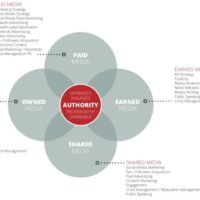
B2B digital marketers are obsessing over how to make social media relevant for lead generation.
Social media is a key component of any inbound marketing strategy and despite initial hesitations, companies are now recognising its potential in generating value for their brand by engaging directly with their fans, customers and followers.
But how do they capture that value? How can a “like”, a “comment” or a “follower” be transformed into a lead and eventually a customer
Today strategy: drive more traffic to get more customers
In the last few years, B2B marketing has relied on the funnel concept, a simplified four step marketing strategy:
- Identify a potential market (Awareness)
- Send valuable content to your audience (unknown prospects) through multiple channels, mainly social media (Interest)
- Attract their attention and drive them to a landing page (Desire)
- Ask them to register to receive the promised content (Action – transform unknown prospects into known)

If you can attract 100 unknown users to your site, the marketing funnel experience says that you can realistically expect a conversion of no more than 1% or 2% (1 or 2 registrations).
Yes, you can always try to increase the number of visitors to your landing page by running a paid media campaign, but that wouldn’t necessarily change the conversion’s percentage.
Take a LinkedIn Sponsored Content campaign for example. On LinkedIn it’s easy to target a B2B audience thanks to its targeting options: job title, job function, company size, etc. So, let’s assume that you want to target Chief Information Officers (and similar positions) across industries in the UK; you will have a target audience of about 20K people.
The average click-through rate is approximately 0.4%, (https://business.linkedin.com/en-uk/marketing-solutions/blog/posts/linkedin-advertising/2016/Benchmarking-and-Optimisation-for-LinkedIn-Advertising1) but there’s no reason you can’t reach a higher CTR – say, 1.5%.
Taking your target audience of 20k, statistics say 300 prospects will go to the landing page, three will register (1% conv. rate), and then the three digital leads will be passed to the telemarketing agent who will probably convert one into a MQL. The average CPC is €5 (https://blog.adstage.io/2017/09/19/linkedin-cpc-increase-2017/) which means you will likely invest €2,000 or more (media spend + creative production) to only achieve a single qualified lead.
The lesson here is there are a number of limitations to a funnel marketing strategy and striving to reach a higher number of prospects in an attempt to increase your conversion rate is an expensive and potentially inefficient strategy.
Pitfalls of the funnel model:
- High Cost Per Lead
- Conversation rate remains the same or doesn’t increase significantly
- Social media marketing seen as a tactic at awareness stage (top of the funnel)
Flip the funnel – how to increase conversation rate with an Account-Based Marketing strategy
The objective should be improving the conversation rate by targeting a limited, yet valuable number of prospects who are showing an interest at a specific point in time (Buyer Intent).
This is what marketers call an Account-Based Marketing strategy: a company must focus on the accounts that really matter to optimise its investment. But how can a company identify those contacts who are worth focusing on among its audience?
Marketing technology available today allows marketers to analyse the online behaviour of their target audience by identifying prospects who show an intent to buy or a high interest in a specific product, solution or brand.
Social listening software, like Brandwatch, listens to conversations on relevant topics through social media channels and identifies the authors who’ve made specific actions (triggers), such as share a specific tweet or follow a specific account, etc…
Referring back to our earlier example, you want to target CIOs because you’re a company that offers cybersecurity solutions. You start listening to conversations around cybersecurity taking place on social media and identify a number of relevant authors who are highly interested in cybersecurity.
Thanks to marketing technology you can now retrieve the necessary information to create a full profile including their LinkedIn profile, job title, company email address, company name and other elements.
The final step would be to filter out those prospects who are not in line with our target audience; resulting in a list of hot prospects that we can nurture with different marketing tactics.
Assuming you already have a list of CIOs, and want to learn which hot prospects to focus on, you can identify them by starting with your given database. In this case, the same methodology can be used by reversing the workflow:
– Start with a list of known prospects with full name, business address and company name details (a standard database from any B2B companies would be like that)
– Build their social media profile with the available data
– Once profiled, start listening to their conversations
– Based on the established triggers, you can identify targeted prospects who show an interest in our product, solution or brand.
The result will be the same: a list of hot prospects who show an intent to buy.
Conclusion
Most B2B companies have embraced the transformation from Outbound to Inbound marketing, and because of that, the competition to attract and engage prospects has raised exponentially in the last years.
An Account Based Marketing strategy proposes an efficient alternative to the traditional funnel where at the top of it the key activity is no longer addressing a large audience, but identifying which targeted accounts to focus on.
To do that, a Buyer Intent analysis can help you discover those hot prospects worth targeting and nurturing.

Click here to find out more about Account Based Marketing
About Guest Contributor: Marco Ottonello has been working in Digital Marketing for nearly 20 years. He has helped companies like Motorola, IBM, HPE and France Telecom, to implement multi-channel marketing strategies focused on digital. Not only has he achieved results in terms of sales and leads generated but also has been a digital evangelist inside the organizations leading the digital transformation.




